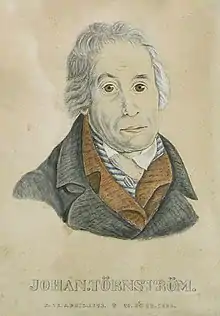Johan Törnström
Johannes ("Johan") Törnström (April 17, 1743, in Ekeby, Västmanland – February 20, 1828, in Karlskrona) was Admiralty sculptor to the Swedish Navy at the Karlskrona naval base. He carved a number of figureheads for naval vessels, which are now housed at the Marinmuseum.

Early years
The son of a farmer, Törnström apprenticed in Stockholm with the wood sculptor GJ Fast, and with the Frenchman Jean-Baptiste Masreliez (or Maserliez) (1753–1801). While Masreliez trained Törnström in wood carving and cabinet making, he never received formal training at the Royal Swedish Academy of Arts.[1] His work, and that of Fredrik Henrik af Chapman, the Swedish Naval officer and shipbuilder, was inspired and influenced by the Neoclassical ideas of Admiral Augustin Ehrensvärd.[2][3]
Career
Törnström worked for a time as a furniture carver; he created works for the Stockholm Royal Palace until 1781;[4][5] he created carvings for ships. Most likely, Törnström became acquainted with af Chapman during this time.[6]
In 1781, af Chapman became manager of the Karlskrona shipyard, and summoned Törnström to become the official figurehead carver to the Navy.[1][4] From 1782 to 1818,[7] he worked at the shipyard's Sculptor’s Workshop, which was originally built in the 1760, but whose masque crowning was redesigned by Törnström in a Neoclassical architectural style, meant to represent the classical Greek goddess of drama.[8][9] He created most of the figureheads for 19 frigates (female depictions) and 15 ships of the line (male depictions) during his years at the Karlskrona shipyard. The oak carvings depicted Neoclassical figures, which could be more than 10 feet (3.0 m) in height and could take as much as 24 months to complete.[4] While his style was described as "rugged" and "chunky",[10] and evoked antique ideals as patriotic works,[11] his female figures were characterized as buxom, wearing diaphanous clothing.[12] Several of his figureheads are part of the collection at the Marinmuseum on Stumholmen Island in Karlskrona, ten of which arrived in the 1960s.[6]
When the Navy suspended shipbuilding in 1790, Törnström created works for churches to provide for his family of ten children.[4] He became a member of the Royal Swedish Academy of Arts in 1803. In 1814, he created the altarpiece and pulpit for the German Church in Karlskrona (Heliga Trefaldighetskyrkan; also, "Church of Holy Trinity").[13] He died in 1828.
Gallery
Some of Törnström's figureheads are on display at the Marinmuseum. They include Minerva, Fäderneslandet ("Fatherland"), Fröja, Camilla, Galatea, Försiktigheten ("Prudence"), Äran ("Honour"), Dristigheten, La Badine och Carl XIII.[14]
 Svea for the gunship Fäderneslandet (1783)
Svea for the gunship Fäderneslandet (1783) "Äran" for the ship of the line Äran (1784)
"Äran" for the ship of the line Äran (1784) La Badin for the brigantine Le Badin (1815)
La Badin for the brigantine Le Badin (1815) The goddess of "Victory" for the gunship Carl XIII (1819)
The goddess of "Victory" for the gunship Carl XIII (1819)
References
- Harris, Daniel G. (19 January 1989). F. H. Chapman: the first naval architect and his work. Conway Maritime. pp. 59. 116, 122, 127. ISBN 978-0-85177-486-2. Retrieved 22 June 2012.
- Comité international d'histoire de l'art; Comité français d'histoire de l'art (1992). L'art et les révolutions: L'art au temps de la révolution française. Société alsacienne pour le développement de l'histoire de l'art. p. 313. Retrieved 22 June 2012.
- "Om skolan". Ehrensvärdska Gymnasiet (in Swedish). Retrieved 23 June 2012.
- Stammers, Michael (1 November 2005). Figureheads & Ship Carving. Naval Institute Press. pp. 98–. ISBN 978-1-59114-274-4. Retrieved 23 June 2012.
- Hasselgréen, Ingmar (1974). Konstsamlaren Gustaf Adolf Sparre, 1746–1794: hans studieresa, våning och konstsamling i Göteborg. s.n. p. 206. Retrieved 22 June 2012.
- American Bureau of Shipping (1980). Surveyor. American Bureau of Shipping. Retrieved 22 June 2012.
- Hansen, Hans Jürgen (1968). Art and the seafarer: a historical survey of the arts and crafts of sailors and shipwrights. Viking Press. p. 125. Retrieved 22 June 2012.
- "The Old Navy Yard". Karlskrona Kommun. Retrieved 23 June 2012.
- "Marinbasen, Karlskrona". Mraitime Heritage Atlas of South Baltic. Retrieved 23 June 2012.
- Norton, Peter (1976). Ships' figureheads. Barre Pub. p. 100. ISBN 9780517525616. Retrieved 23 June 2012.
- Taideteollisuusyhdistys, Suomen (1 January 1986). Form function Finland. Finnish Society of Crafts and Design. p. 21. Retrieved 22 June 2012.
- Clark, Sydney (1962). All the best in Scandinavia. Dodd, Mead. p. 186. Retrieved 22 June 2012.
- "Church of the Holy Trinity". karlskrona.se. Retrieved 23 June 2012.
- Marinmuseum. "Galjonsfigurer av Johan Törnström" (in Swedish). Marinmuseum, Stumholmen, Karlskrona – en del av Statens maritima museer. Archived from the original on 3 April 2012. Retrieved 23 June 2012.
Further reading
- Halldin, G. (1940). Johan Törnströms galjonsbilder (in Swedish)
- Reyde, F., & Tortuna hembygdsförening. (1976). Johan Törnström: Bondpojken från Tortuna som blev kungl. bildhuggare i Karlskrona (in Swedish)
- Färnström, M., Ellis, N., Vang, B., & Marinmuseum (Karlskrona). (1994). Johan Törnström 1744–1828 (in Swedish)